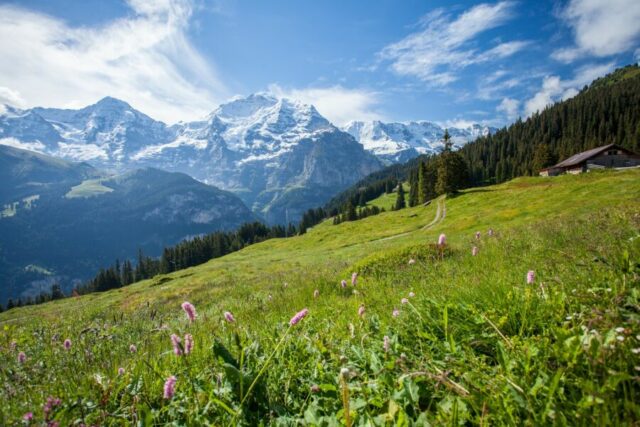When this pandemic is all over, I can’t wait to get back to Europe. And the first hike I’d like to take is high above the Lauterbrunnen Valley, in Switzerland, with my friend Olle. I’ve been thinking back on one of my favorite such hikes.

Even if we’ve had to postpone trips to Europe, I believe a daily dose of travel dreaming can actually be good medicine. Here’s another one of my favorite travel memories — a reminder of what’s waiting for you in Europe at the other end of this crisis.
It’s a glorious Swiss Alps morning. I’m spending my day walking with my schoolteacher friend, Olle, exploring the alpine landscape surrounding his home in Gimmelwald. Before we’re too far along, I realize I’m getting a blister.
Opening his rucksack on a rock, Olle asks me to take off my shoe and sock. Muttering that he can’t believe how tourists tackle these mountains without good hiking boots, he fits some moleskin around my tender toe. As Olle works, I lie back on the rugged tufts of grass growing through the pebbly shale.
We continue on, following a faint path along the ridge. I stop every few steps to enjoy vast views of the Schilthorn on our left and the Jungfrau on our right. Olle takes on his teacher’s voice: “We respect nature more than the tourists do. When there’s an avalanche warning, we take the gondola down. Tourists continue sledding. There are many accidents. In Lauterbrunnen, maps show red flags for places of mountain injuries and black ones for deaths.” Pointing to the towering rock cliff of the mountain over the valley directly ahead of us, he says, “The Eiger is solid black.”
As I squint up at a wasp-like helicopter, Olle answers my question before I ask it. “Those are mostly sightseeing trips. But even sightseeing trips are related to mountain rescue. As they show a tourist around, they are practicing for emergency rescues.”
“Are there really dead climbers hanging from ropes on the Eiger?” I ask.
“Yes,” says Olle. “It’s sad when bodies are finally recovered. They look like they did when we saw them last, except with a very light beard. You can tell from the beard how long they lived. The family has to identify them.”
The weather can turn at any time. Just last month, a storm hit fast. Within a few minutes, five people died: three mountaineers on the Eiger, one on the Mönch, and one in the air — a paraglider.
I tell Olle of a harrowing experience I had back in my youth-hostel days. We’d hike up the Schilthorn from the hostel with a plastic bag, sit on the bag, and slide down the glacier — breathtaking fun. As a reckless young tour guide, I’d lead my groups down the mountain in the same way.
One day, late in the season, sliding on an icy but smaller-than-usual sliding field, I started going out of control. Hurtling directly toward the rocky edge, I didn’t know what to do, but I did know I had to do something. After almost too much time to consider my options, I dug my hands like brakes into the rocky ice. Going through several degrees of burn in a matter of seconds, I ground to a halt with blackened, blistered, and bleeding hands — and a bloody butt.
My group heralded me as a hero. But in the doctor’s office in Mürren, I was scolded as a fool, the whipping boy for all the stupid tourists who disrespect the power of the mountain. The doctor didn’t even bother to clean my hands. He lectured me, sprayed something on my wounds, and bandaged me. I left knowing that the little bits of Schilthorn embedded in my palms would come out only in the pus of a later infection.
Olle nods, as if in support of the doctor, and says, “This happens many times.”
He tells me that even cows become victims of the mountains, occasionally wandering off cliffs. Alpine farmers expect to lose some of their cows in “hiking accidents.” These days, cows are double the weight of cows a hundred years ago and no less stupid. If one wanders off a cliff in search of greener grass, the others follow. Farmers tell their sons about the time at the high Alp above Gimmelwald when a dozen cows performed this stunt…and died like lemmings. Helicopters recover the dead cows, flying them out, but because the meat must be drained of blood immediately for human consumption, it’s wasted. It’s meat fit only for dogs.
As we continue our walk, a pastel carpet of flowers trims the scene: golden clover, milk kraut, bellflowers, daisies. “For me, it’s like meeting old friends when the flowers come out again in the spring,” Olle says. All but abandoning me for the flowers, he rummages through his rucksack and pulls out a weathered handbook describing the local flora. “My bible,” he says. “When the cows eat this grass with all these flowers…it is a good mix for the milk.”
“Okay, Rick, you will now risk your life for a flower.” He leaves the trail and creeps over an edge and out of sight to find an edelweiss. Loose rocks, huge drop, no helicopter in sight…I don’t really care about finding edelweiss.
Then I hear Olle holler, “Yes, I found some! Come around.”
Feeling fat and clumsy, I leave the trail. Pulling gingerly at weed handholds, I work my way around a huge rock and across a field of loose shale. Olle comes into view, looking younger than he did a moment ago. “There are three edelweiss here. But this is a secret for only you and me. This spot must not go in your guidebook.” At this point I am not concerned about my guidebook, only my survival. Olle grabs my hand with hands that have grown strong and tough after 14 years of high-altitude village life.
As if to pump up the drama, he whispers, “For me, it would not be a hike without a little danger.”
“That’s why your school is so small,” I whisper under my breath.
“Edelweiss. It means ‘noble white.’ In the valley, it’s noble gray. Only at high elevations do they get this white. UV rays give all flowers brighter colors at this altitude.” Creeping with me to the ledge, Olle gently bends three precious edelweiss toward the sun. Pinching off a petal, he assures me, “This will not affect reproduction.”
Petting a petal gently, I note that it feels like felt.
“Yes, like felt,” Olle agrees. “This protects the plants from dehydration. I collect and press flowers but have never pressed an edelweiss. Edelweiss has been picked nearly to extinction.”
As we struggle back to the trail, Olle talks on. “Here in Switzerland we are getting serious about our environment. Twenty years ago, our rivers and lakes were very polluted. Today you can nearly drink out of Lake Thun. Now we understand. You don’t pee in your living room, do you?”
I assure him that I do not.
Finally reaching the safety of the trail, we walk more quickly, with ease. “Do farmers mind if we walk through their property?” I ask.
“This is a human right — to walk through the land,” Olle says. His environmental passion crescendos with his voice. “When I was in Boston, I asked, ‘How can I get to the lake?’ They told me, ‘You can’t, it is private.’ That is for me perverse. This is unthinkable here in Switzerland. We are guests of this Earth.” Like welcome guests, we make ourselves at home, stopping at a peak that stands dramatically high above Gimmelwald. Olle shares a snack as we sit quietly to savor our perch.
Switchbacking steeply back down, we pass through a thick forest and step out at the top end of Gimmelwald. We’re cheered on by a fragrant finale…a field vibrant with flowers, grasshoppers, bees, crickets, moths, and butterflies.
Olle says, “This year farmers obeyed tradition and not their eyes. They waited too long and had to take cows directly to the high Alps. They skipped this lower field. For these flowers, it is a fine year — no hungry cows.”
Switzerland embraces its traditions with such gusto that locals like Olle fear visitors think it’s an underdeveloped nation. It’s certainly not. And the good news: The traditional alpine culture survives most heartily — like edelweiss — in its most remote corners.
(This story is excerpted from my upcoming book, For the Love of Europe — collecting 100 of my favorite memories from a lifetime of European travel. It’s coming out in July, and available for pre-order.)
from Rick Steves' Travel Blog https://ift.tt/2VZg7B4








No comments:
Post a Comment